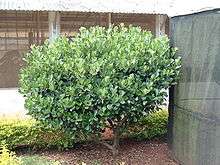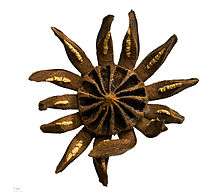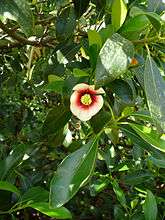Clusia
Clusia is the type genus of the flowering plant family Clusiaceae. Comprising 300-400 species, it is native to tropical America. The genus is named by Carl Linnaeus in honor of the botanist Charles de l’Écluse.
| Clusia | |
|---|---|
 | |
| Clusia fluminensis | |
| Scientific classification | |
| Kingdom: | Plantae |
| Clade: | Tracheophytes |
| Clade: | Angiosperms |
| Clade: | Eudicots |
| Clade: | Rosids |
| Order: | Malpighiales |
| Family: | Clusiaceae |
| Tribe: | Clusieae |
| Genus: | Clusia L. |
| Species | |
|
more than 400, see text | |
| Synonyms | |
|
Arrudea Cambess. | |

The closest relatives of Clusia are the neotropical genera Chrysochlamys, Tovomita, Dystovomita and Tovomitopsis. Together with Clusia, these genera form the tribe Clusieae, where the fruit is a fleshy capsule with arillate seeds.
The distribution ranges from the Florida Keys and southern Mexico to southernmost Brazil, and from near sea level to at least 3500 m altitude in the northern Andes. Species of Clusia are a characteristic component of a number of Neotropical vegetation types, and may even be dominant, as is often seen in montane forests of the Greater Antilles. Most species are found in lowland or montane rainforests, but some occur in drier habitats such as the restingas of Brazil, caribbean coastal scrub and dry interandean valleys. A number of species are confined to rocky habitats, such as tepuis or granitic inselbergs. A few grow as scattered shrubs in paramo. The apomictic Clusia rosea is an invasive alien in Hawaii and Sri Lanka, and possibly elsewhere.
Description
Its species are shrubs, vines and small to medium-size trees up to 20 m tall, with evergreen foliage. Some species start life as epiphytes which grow long roots that descend to the ground and eventually strangle and kill the host tree in a manner similar to strangler figs.
Many Clusia species have Crassulacean acid metabolism, which can be considered an adaptation to the often dry (micro)habitats of the genus.
The plants contain variously coloured latex in stems, leaves and fruit. The leaves are opposite, 5–20 cm long and 2–10 cm broad, with a leathery texture and an entire margin. Flower size varies from ca 5 mm wide (e.g. Clusia gundlachii) to ca 150 mm in Clusia grandiflora. The 4-9 petals are white, cream, yellow, pink, red, blackish or green. Flowers are unisexual and plants are dioecious (pistillate and staminate flowers are borne on separate plants). Stamen number ranges from four to several hundred. Shape and size of stamens are extremely variable. Sterile stamens are often present, both in pistillate and staminate flowers. Stigmas are four to 16 in number and usually sessile. The fruit is a leathery valvate capsule which splits open to release several red or orange, fleshy-coated seeds.
Pollination involves a range of different animals, and several types of rewards. Floral resin occurs in many, probably most species of Clusia. The resin is produced by the stamens (by sterile stamens, referred to as staminodes, in pistillate flowers) and is collected by bees that use it in nest construction. Nectar is most common in montane species, e.g. Clusia clusioides, and these flowers are visited by insects such as moths and wasps, and sometimes by bats or hummingbirds. In flowers lacking nectar or resin, pollination may be carried out by pollen-eating beetles, which visit also the rewardless pistillate flowers, as observed in Clusia criuva. Clusia blattophila is pollinated by male cockroaches attracted by a pheromone-containing fluid produced by the flowers. [1]
Seeds are dispersed by birds and perhaps, in some cases, by small mammals.
Clusia plants provide excellent nesting sites for some insects. For instance, Clusia grandiflora, a common species in Guianese forests, is an attractive place for Polistes pacificus wasps to build their paper nests because arboreal ants, which often prey on these wasps, do not normally reside in this species of tree.[2]
Uses
The wood of Clusia is highly durable, and is sometimes used for roof construction. The latex and the floral resin have antiseptic properties and have been used to seal wounds. Dry latex is sometimes burned like incense in churches. A few species are grown as house plants, or, in tropical areas, as ornamental trees and shrubs. Examples are Clusia rosea, C. major and C. orthoneura.
Selected species
- Clusia alata
- Clusia amazonica
- Clusia blattophila
- Clusia bracteosa
- Clusia carinata
- Clusia caudata
- Clusia celiae
- Clusia clarendonensis
- Clusia clusioides
- Clusia cochlitheca
- Clusia croatii
- Clusia colombiana
- Clusia columnaris
- Clusia congestiflora
- Clusia crenata
- Clusia cuneifolia
- Clusia cupulata
- Clusia decussata
- Clusia dixonii
- Clusia ducu
- Clusia ducuoides
- Clusia duidae
- Clusia elliptica
- Clusia flava
- Clusia flavida
- Clusia fluminensis Planch. & Triana
- Clusia fockeana
- Clusia frigida
- Clusia fructiangusta
- Clusia garciabarrigae
- Clusia gardneri
- Clusia grandiflora
- Clusia gundlachii
- Clusia hammeliana
- Clusia haugtii
- Clusia hilariana
- Clusia hydrogera
- Clusia hyleae
- Clusia insignis
- Clusia lanceolata
- Clusia latipes
- Clusia laurifolia
- Clusia laxiflora
- Clusia leprantha
- Clusia lineata
- Clusia longipetiolata
- Clusia longistyla
- Clusia loretensis
- Clusia magnoliiflora
- Clusia major
- Clusia melchiorii
- Clusia mexiensis
- Clusia minor
- Clusia minutiflora
- Clusia nemorosa
- Clusia nubium
- Clusia octandra
- Clusia orthoneura
- Clusia osseocarpa
- Clusia pallida
- Clusia palmicida
- Clusia panapanari
- Clusia penduliflora
- Clusia pernambucensis
- Clusia platystigma
- Clusia plurivalvis
- Clusia polystigma
- Clusia portlandiana
- Clusia pseudomangle
- Clusia pulcherrima
- Clusia renggerioides
- Clusia rigida
- Clusia rosea – Scotch attorney, autograph tree, pitch-apple
- Clusia schomburgkiana
- Clusia sellowiana
- Clusia skotaster
- Clusia sphaerocarpa
- Clusia spiritu-sanctensis
- Clusia stenophylla
- Clusia tarmensis
- Clusia thurifera
- Clusia triflora
- Clusia trochiformis
- Clusia uvitana
- Clusia valerioi
- Clusia venusta
- Clusia viscida
- Clusia weberbaueri
- Clusia weddelliana
Gallery
-_leaf_with_autograph%2C_flower%2C_fresh_fruit%2C_and_dried_fruit.jpg) Autograph tree (C. rosea): leaf with autograph, flower, fresh fruit, and dried fruit.
Autograph tree (C. rosea): leaf with autograph, flower, fresh fruit, and dried fruit. Clusia lanceolata, Fairchild Tropical Botanic Garden
Clusia lanceolata, Fairchild Tropical Botanic Garden
References
- Vlasakova, Blanka; et al. (2008). "Cockroaches as pollinators of Clusia sp. aff. sellowiana (Clusiaceae), on inselbergs in French Guiana". Annals of Botany.
- Corbara, Bruno; et al. (2009). "Diversity and nest site selection of social wasps along Guianese forest edges: assessing the influence of arboreal ants". Comptes Rendus Biologies. 332: 470–479. doi:10.1016/j.crvi.2009.01.003.
Correia MCR, Ormond WT, Pinheiro MCB, Lima HA (1993) Estudos da biologia floral de Clusia criuva Camb. um caso de mimetismo. Bradea 24:209–219
Gustafsson, M. H. G. and V. Bittrich (2003) Evolution of morphological diversity and resin secretion in flowers of Clusia L. (Clusiaceae): insights from ITS sequence variation. Nordic Journal of Botany 22: 183-203.
Gustafsson, M. H. G. (2012) A new xeromorphic species of Clusia (Clusiaceae) from dry valleys of northern Peru. Novon 20: 414-417
Gustafsson, M. H. G., V. Bittrich and K. Winter (2007) Diversity, phylogeny and classification of Clusia. In U. Lüttge (ed.) Ecological studies vol. 194. Clusia: a woody Neotropical genus of remarkable plasticity and diversity, pp. 95–116. Springer, Heidelberg.
Bittrich, V and M. C. E. Amaral (1996)Flower Morphology and Pollination Biology of Some Clusia Species from the Gran Sabana (Venezuela) Kew Bulletin 51: 681-694.
External links
![]()
- Clusia rosea photos
- Key to Clusia species from Brazil (in Portuguese)